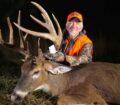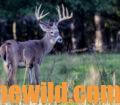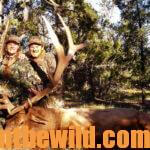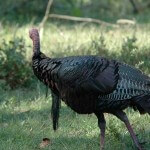Editor’s Note: The first week of deer season in any state usually creates the highest amount of hunting pressure in the deer woods. Thanksgiving, the Christmas holidays and the last week of deer season also are times of the year when the numbers of deer hunters drastically increase – and don’t forget weekends. So, if you hunt at these times of year, longtime, avid deer hunter Terry Drury, who with his brother Mark Drury created Drury Outdoors, offers these suggestions. Drury often has to hunt high-pressured deer and through his experience knows the tactics for taking them.
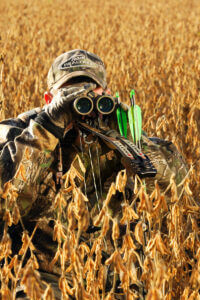 Hunters who pressure deer will push deer out of locations when they scout, walk, look, stomp, tromp and just hang out. To avoid that, we designate certain places as sanctuaries, and we won’t walk through them. Absolutely under no circumstances will we walk through the sanctuaries, unless we must recover an animal from those places. Nine times out of 10, if a sanctuary never has had a human walk through it, then the deer will feel very comfortable there, particularly in a bedding area. Often a buck will find sanctuary in a huge thicket, a big block of timber, a large tangle of wild roses, a locust tree patch or other thick growth. The deer will feel safe there because they don’t smell any human scent or any foreign substance and haven’t heard any grunting or rattling in that place. Hunt only the perimeters of those regions, because when a buck feels pressured, he’ll retreat to that area.
Hunters who pressure deer will push deer out of locations when they scout, walk, look, stomp, tromp and just hang out. To avoid that, we designate certain places as sanctuaries, and we won’t walk through them. Absolutely under no circumstances will we walk through the sanctuaries, unless we must recover an animal from those places. Nine times out of 10, if a sanctuary never has had a human walk through it, then the deer will feel very comfortable there, particularly in a bedding area. Often a buck will find sanctuary in a huge thicket, a big block of timber, a large tangle of wild roses, a locust tree patch or other thick growth. The deer will feel safe there because they don’t smell any human scent or any foreign substance and haven’t heard any grunting or rattling in that place. Hunt only the perimeters of those regions, because when a buck feels pressured, he’ll retreat to that area.
Some of these sanctuaries the deer use as feeding places. We never allow a human to go in to a sanctuary like this, unless he’s planting or harvesting crops. As long as the deer don’t feel pressure from humans, those deer will be comfortable coming to and from those regions. So, we catch them on the perimeters of highly-pressured areas going to the sanctuaries where they don’t feel pressured. This strategy has worked time and time again for us.
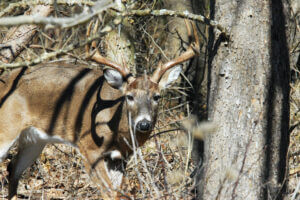 You don’t have to have but a 5-acre, a 10-acre, a 20-acre or a 50-acre patch of sanctuary land, and it doesn’t take a lot of money to buy a small parcel near your property. As long as you never penetrate that sanctuary, you easily can catch deer slipping in and out of that small piece of land.
You don’t have to have but a 5-acre, a 10-acre, a 20-acre or a 50-acre patch of sanctuary land, and it doesn’t take a lot of money to buy a small parcel near your property. As long as you never penetrate that sanctuary, you easily can catch deer slipping in and out of that small piece of land.
Often a hunter may have a difficult time not hunting the deer in sanctuary areas. When you know where a buck holds, and you feel certain you can take him, you begin to think to yourself, “I know that I shouldn’t hunt the sanctuary when the wind blows in the wrong direction. But, if I don’t hunt that spot today, I won’t have the chance to hunt it again until next week, or maybe not until next year. I know I may spook the buck, but I plan to hunt him anyway.”
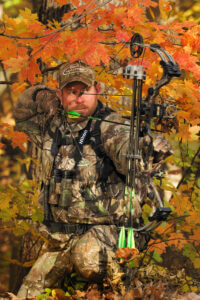 If you hunt a deer on a day when you shouldn’t hunt a deer, you may run him out of that sanctuary and never see him again. Once you’ve discovered the sanctuary, only hunt a mature buck on a day when the wind blows in the correct direction, and all the conditions seem right, so you won’t spook the buck. Don’t try and take that buck during hunting season this year. Instead, hunt him next year. If you spook him off the property you hunt on to someone else’s land, then you’ve gained nothing and lost everything.
If you hunt a deer on a day when you shouldn’t hunt a deer, you may run him out of that sanctuary and never see him again. Once you’ve discovered the sanctuary, only hunt a mature buck on a day when the wind blows in the correct direction, and all the conditions seem right, so you won’t spook the buck. Don’t try and take that buck during hunting season this year. Instead, hunt him next year. If you spook him off the property you hunt on to someone else’s land, then you’ve gained nothing and lost everything.
You also may think, “My hunting buddies and I will surround the buck’s sanctuary and put on a man-drive. Maybe one of us will get a shot at him when he breaks from thick cover.”
This buck knows all about man-drives. He most likely will dodge the group of standers, and no one will get a shot at the buck. Once again, you will have run the deer off your land onto someone else’s property.
Next, you’ll think, “I’ll go into that sanctuary and just check and make sure that the buck hasn’t left the area before I spend the day trying to hunt him.” If you make this decision on the day you decide to hunt him, he probably already will have left that site.
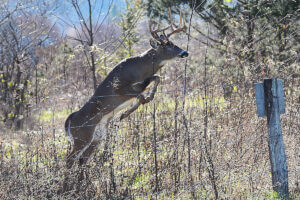 Hunting a big buck that feels pressure from other hunters is like hunting a man-eating tiger. If you don’t pick the best day and the best time to hunt him, he’ll beat you. He may not eat you up, but you’ll turn into his trophy because he’s outsmarted one more hunter. Trophy bucks are difficult to hunt. However, you can take them on high-pressured lands if you not only study the deer, but also study the hunters who hunt them.
Hunting a big buck that feels pressure from other hunters is like hunting a man-eating tiger. If you don’t pick the best day and the best time to hunt him, he’ll beat you. He may not eat you up, but you’ll turn into his trophy because he’s outsmarted one more hunter. Trophy bucks are difficult to hunt. However, you can take them on high-pressured lands if you not only study the deer, but also study the hunters who hunt them.
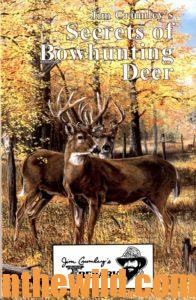 To learn more about hunting for deer, check out John E. Phillips’ bowhunting book, available in Kindle and print, “Jim Crumley’s Secrets of Bowhunting Deer” at http://amzn.to/XYTCEY and soon to be available in Audible before December 1. You may have to copy and paste this link into your browser. (When you click on the book, notice on the left where Amazon says you can read 10% of the book for free). To see more of John’s bowhunting books, visit www.amazon.com/author/johnephillips.
To learn more about hunting for deer, check out John E. Phillips’ bowhunting book, available in Kindle and print, “Jim Crumley’s Secrets of Bowhunting Deer” at http://amzn.to/XYTCEY and soon to be available in Audible before December 1. You may have to copy and paste this link into your browser. (When you click on the book, notice on the left where Amazon says you can read 10% of the book for free). To see more of John’s bowhunting books, visit www.amazon.com/author/johnephillips.

